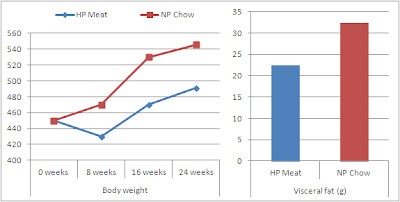Red Meat and Even Pork is Good for You!? Reduced Weight Gain, Improved Insulin Sensitivity and No Adverse Side Effects from "Red Meat Supplementation" Even in Rodents!
Additional(!) 200g of Pork a Day Build Lean Mass, Improve Blood Lipids & Glucose Levels" from September 2011, when a couple of weeks ago yet another "anti-meat study" hit mainstream media news. You will probably have read enough of the certainly accurate, but in a way pointless criticism of the study, elsewhere in the bloggosphere, so that I decided not to repeat the argumentation, which basically discards the value of all epidemiological data (as long as it is not interpreted in accordance with the respective blogger ;-)... now, not all scientists are epidemiologists, some, like Petzke et al. (see the post I mentioned before) or, more recently Haiyan Chen and his (or her?) Chinese co-workers actually care to conduct experiments on the health effects of red meat consumption and their results are by no means as unequivocal (Chen. 2012), as the introductions and dead-certain conclusions of the epidemiologist would suggest.
If you want to lose weight and ward off diabesity, you "supplement" with red meat!
In their 24 week trial, Chen et al. kept a group of 24 male Wistar rats, who had been pre-fattened on the standard SAD-like "high fat diet" for 14 weeks (an interesting side note: only 24 of the 46 rats who received the HFD diet got actually obese, i.e. they gained +20% more body-fat than their peers - so what does that tell you about the "general" fattening effect of the "high fat diet"?) on either
As you can see in figure 1 the addition of the "unhealthy red meat" (remember: neither was this "healthy chicken" nor grass-fed beef, but Chinese pork meat - similar to the lean cuts of pork that made the women in the Petzke study lean out and build muscle) reduced the weight gain of the already obese 17-week old rodents by more -57% (!) and left them with 44% less of pro-inflammatory visceral fat mass than their peers on the healthy "meat-less" standard chow. Despite an increase in BUN, the creatinine levels of both groups were identical and there were no signs of kidney damage in any of the rodents kept on the meat-supplemented high protein diet.
The insulin response during an intravenous glucose tolerance test (a measure of insulin resistance), on the other hand, was reduced, just as fasting GLP-1 levels were (P < 0.05; for more information on the intricate relationship between GLP-1, insulin and obesity / fat loss, check out my previous post on WMHDP).
Why the different results? Don't tell me meat is not bad for me!
Aside from the questionnaire based epidemiological studies, where "Pizza Salami" is a "red meat food", I mentioned earlier, there definitely is experimental data (on which the working hypothesis of many of the epidemiological studies are founded, by the way) that would suggest that feeding red meat to rodents is not the best thing to do... now, if we discard species-specific issues for the time being, how can those differences be explained? Chen et al. provide a pretty straight-forward set of potential confounding factors in their discussion, which I am going to summarize for you:
If you want to lose weight and ward off diabesity, you "supplement" with red meat!
In their 24 week trial, Chen et al. kept a group of 24 male Wistar rats, who had been pre-fattened on the standard SAD-like "high fat diet" for 14 weeks (an interesting side note: only 24 of the 46 rats who received the HFD diet got actually obese, i.e. they gained +20% more body-fat than their peers - so what does that tell you about the "general" fattening effect of the "high fat diet"?) on either
- regular rodent chow with 67.8% of energy from carbohydrates, 12.8% fat and 19.4% protein, or
- red-meat enriched "high" protein diets with 46.6% of energy from carbohydrates, 16.7% fat and 36.7% protein
 |
| Figure 1: Body weight (in g) during and visceral fat (in g) after 24 weeks on high protein meat or normal protein chow diets (data adapted from Chen. 2012) |
 |
| Figure 2: Insulin AUC during intravenous glucose tolerance test (IGGT) and fasting GLP-1 levels (data adapted from Chen. 2012) |
Why the different results? Don't tell me meat is not bad for me!
Aside from the questionnaire based epidemiological studies, where "Pizza Salami" is a "red meat food", I mentioned earlier, there definitely is experimental data (on which the working hypothesis of many of the epidemiological studies are founded, by the way) that would suggest that feeding red meat to rodents is not the best thing to do... now, if we discard species-specific issues for the time being, how can those differences be explained? Chen et al. provide a pretty straight-forward set of potential confounding factors in their discussion, which I am going to summarize for you:
- meat is an energetically denser protein source than dairy - this may explain why, compared to dairy products, meat has been found to be positively associated with weight gain in rats (eg. Belobrajdic. 2003)
- the longer experimental duration - in previous studies there were already "tendencyies toweight loss" at the end of the mostly 10-12 week study periods
- the age of the animals may have a profound effect on the weight gain; for rats that are younger than the ones in the study at hand, an increased weight could would in fact indicate a healthy effect during the most active growth period of the rodents rats; this would not preclude, though that the same diet would facilitate weight loss in mature rats



